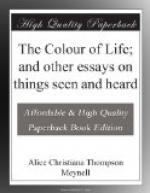The art of Japan has none but an exterior part in the history of the art of nations. Being in its own methods and attitude the art of accident, it has, appropriately, an accidental value. It is of accidental value, and not of integral necessity. The virtual discovery of Japanese art, during the later years of the second French Empire, caused Europe to relearn how expedient, how delicate, and how lovely Incident may look when Symmetry has grown vulgar. The lesson was most welcome. Japan has had her full influence. European art has learnt the value of position and the tact of the unique. But Japan is unlessoned, and (in all her characteristic art) content with her own conventions; she is local, provincial, alien, remote, incapable of equal companionship with a world that has Greek art in its own history—Pericles “to its father.”
Nor is it pictorial art, or decorative art only, that has been touched by Japanese example of Incident and the Unique. Music had attained the noblest form of symmetry in the eighteenth century, but in music, too, symmetry had since grown dull; and momentary music, the music of phase and of fragment, succeeded. The sense of symmetry is strong in a complete melody—of symmetry in its most delicate and lively and least stationary form—balance; whereas the leit-motif is isolated. In domestic architecture Symmetry and Incident make a familiar antithesis—the very commonplace of rival methods of art. But the same antithesis exists in less obvious forms. The poets have sought “irregular” metres. Incident hovers, in the very act of choosing its right place, in the most modern of modern portraits. In these we have, if not the Japanese suppression of minor emphasis, certainly the Japanese exaggeration of major emphasis; and with this a quickness and buoyancy. The smile, the figure, the drapery—not yet settled from the arranging touch of a hand, and showing its mark—the restless and unstationary foot, and the unity of impulse that has passed everywhere like a single breeze, all these have a life that greatly transcends the life of Japanese art, yet has the nimble touch of Japanese incident. In passing, a charming comparison may be made between such portraiture and the aspect of an aspen or other tree of light and liberal leaf; whether still or in motion the aspen and the free-leafed poplar have the alertness and expectancy of flight in all their flocks of leaves, while the oaks and elms are gathered in their station. All this is not Japanese, but from such accident is Japanese art inspired, with its good luck of perceptiveness.




